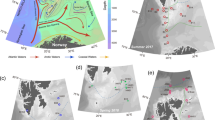Abstract
Under biogenic load and at high abundance of ichthyofauna (the concentration of total phosphorus Ptot = 0.20 mg P/l, mineral phosphorus Pmin = 0.13 mg P/l, and at the ratio N: P = 4: 1 in early summer), zooplankton reduced phytoplankton biomass during summer and autumn and determined high water transparency, reaching >50% of the depth of the water body. It was found that, with a passage of ichthyofauna to artificial food, the trophic press of plankton-eating fish on zooplankton decreases. Under such conditions, with the biomass ratio of plant-eating zooplankton to edible phytoplankton between 0.4 and 7.9, zooplankton can reduce phytoplankton biomass within a day. The major portion (up to 100%) in phytoplankton biomass reduction was due to large-size filterers-phytophages Daphnia longispina and verticators Asplanchna priodonta helvetica.
Similar content being viewed by others
References
Balushkina, E.V., Vinberg. G.G. Dependence between the Body Mass and Length in Planktonic Animals, in Obshchie osnovy izucheniya vodnykh ekosistem (General Principles in Studying Aquatic Ecosystems), Leningrad: Nauka, 1979, p. 169–172.
Gerasimova, T.N. and Pogozhev, P.I., Reduction of the Trophic Status of a Water Body with the Use of Large-Size Zooplankton. Vodn. Resur., 2002, vol. 29, no. 4, p. 450–459 [Water Resour. (Engl. Transl.), vol. 29, no. 4, p. 412–421].
Gerasimova, T.N. and Pogozhev, P.I., Studying the Potential of Food Chain Filterers in the Processes of De-Eutrophication of Water Bodies, Vodn. Resur., 2008, vol. 35, no. 3, p. 370–379 [Water Resour. (Engl. Transl.), vol. 35, no. 3, p. 353–362].
Gerasimova, T.N., Pogozhev, P.I., and Margolina, G.L., The Use of Mesocosms for Improving the Ecological State of Waters and Increasing the Zooplankton Biomass, Vodn. Resur., 1993, vol. 20, no. 2, pp. 219–224 [Water Resour. (Engl. Transl.), vol. 20, no. 2, pp. 190–194].
Kutikova, L.A., Kolovratki fauny SSSR (Rotifers in the Fauna of the USSR), Leningrad: Nauka, 1970.
Malovitskaya, L.M. and Sorokin, Yu.I., Experimental Studies of Nutrition of Diaptomus (Crustacea, Copepoda) with the Use of C14, Tr. Inst. biol. vodokhr AN SSSR, 1960, no. 4 (7), pp. 262–272.
Matvienko, A.M., Zolotistye vodorosli (Yellow-Green Algae), Moscow: Sovetskaya Nauka, 1954.
Pogozhev, P.I. and Gerasimova, T.N., Study of Lake Zooplankton in Medium-Sized Limnocorals, Vodn. Resur., 1994, vol. 21, no. 1, p. 36–40 [Water Resour. (Engl. Transl.), vol. 21, no. 1, p. 31–35].
Pogozhev, P.I. and Gerasimova, T. NA Study of the Habitat Conditions of Zooplankton in a Eutrophic Lake Using Mesocosms with Different Wall Permeabilities, Vodn. Resur., 1997, vol. 24, no. 2, p. 218–223 [Water Resour. (Engl. Transl.), vol. 24, no. 2, p. 196–201].
Pogozhev, P.I. and Gerasimova, T.N., The Effect of Zooplankton on Microalgae Blooming and Water Eutrophication, Vodn. Resur., 2001, vol. 28, no. 4, p. 461–469 [Water Resour. (Engl. Transl.), vol. 28, no. 4, p. 420–427].
Pogozhev, P.I. and Gerasimova, T.N., The Role of Filtering Zooplankton in De-Eutrophication of Water Bodies, Vodn. Resur., 2005, vol. 32, no. 3, p. 371–379 [Water Resour. (Engl. Transl.), vol. 32, no. 3, p. 337–345].
Popova, T.G., Evglenovye vodorosli (Euglena Algae), Moscow: Sovetskaya nauka, 1955.
Sushchenya, L.M., Kolichestvennye zakonomernosti pitaniya rakoobraznykh (Quantitative Regularities of Crustacean Nutrition), Minsk: Nauka i Tekhnika, 1975.
Khlebovich, T.V., The Role of Infusoria and Algae in the Nutrition of Rotifera Asrlanshna priodonta Gosse, Biologiya Vnutrennikh Vod, 2006, no. 3, p. 31–34.
Bernardi, R. and Guissani, G., Are Blue-Green Algae a Suitable Food for Zooplankton? An Overview, Hydrobiologia, 1990, vol. 200/201, pp. 29–41.
Duncan, A., Assessment of Factors Influencing the Composition, Body Size, and Turnover Rate of Zooplankton in Paracrama Samudra, An Irrigation Reservoir in Sri Lanka, Hydrobiologia, 1984, vol. 113, pp. 201–215.
Gliwicz, Z.M., Daphnia Growth at Different Concentrations of Blue-Green Filaments, Arch. Hydrobiol., 1990, vol. 120, no. 1, pp. 51–65.
Schindler, D.W., Evolution of Phosphorus Limitation in Lake, Science, 1977, vol. 195, no. 4275, pp. 260–262.
Author information
Authors and Affiliations
Additional information
Original Russian Text © T.N. Gerasimova, P.I. Pogozhev, 2010, published in Vodnye Resursy, 2010, Vol. 37, No. 6, pp. 671–681.
Rights and permissions
About this article
Cite this article
Gerasimova, T.N., Pogozhev, P.I. The role of zooplankton in phytoplankton biomass decline and water transparency regulation in a water body subject to high organic and mineral load. Water Resour 37, 796–806 (2010). https://doi.org/10.1134/S0097807810060059
Received:
Published:
Issue Date:
DOI: https://doi.org/10.1134/S0097807810060059




